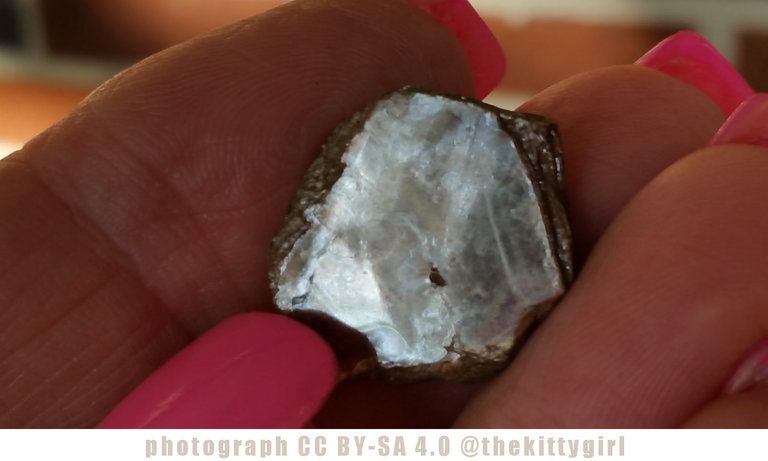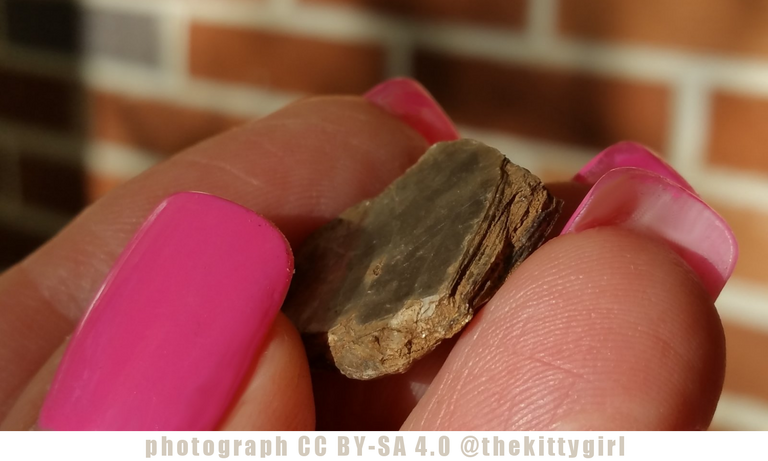Muscovite
As a child, I often remember seeing shiny bits of material in the dirt in our back yard. My father told me it was called mica and that his employer used it in the products they made. Occasionally, we found pieces that had a whitish look to them, but most were a yellowish-brown color and sparkled like gold or silver. Sometimes lighting conditions can make a difference in color, as all of the photos in this post are of a single specimen I collected from the back yard very recently. When held in shadow and reflecting diffused light, the sample appears silver-colored, but in the other shots where the sample is held in light rather than shadow, the true yellowish-brown shows clearly.

So, what is mica...? It is a silicon-based mineral that has "varying amounts of aluminum, potassium, magnesium, iron and water." [2] There are several types of mica, but the most common are: muscovite, phlogopite, biotite, and lepidolite. I don't have any biotite in my mineral collection, but I have the other three. Besides these big four, there's also paragonite, illite, phengite, and a few others.
This specimen is muscovite, which is the most common form of mica found on the earth. Muscovite has the ability to resist heat, so it is used commercially in fireproofing materials. [4] It also has the ability to insulate against electrical current, and that is how my father's employer used it, in the manufacture of capacitors for use in electrical circuits. Muscovite has been found in India in sheets 5 meters × 3 meters (16.5 feet × 10 feet) in size. [4]
The piece I am holding, below, is typical of the size found in this area, but I suspect that larger pieces might be found in the mountains nearby where no land development has taken place. Muscovite is shiny, like a mirror, and reflects light easily. In the following shot, the mica is in sunlight but pointed away from the sun:

And below, it is angled slightly so that it can catch the sunlight and reflect it:

Mica is formed in sheets rather than crystals and a stack of mica sheets is called a 'book' as shown in the following photograph of the mica I am holding. If one looks carefully on the right-side of the specimen, parallel lines of the individual 'sheets' in the 'book' can be seen.

As a child, finding a piece of this shiny mica was like finding gold! I liked to sit in the dirt and dig with a stick, looking for mica and other 'pretty rocks' 😁
 😊
😊SOURCES
1 911metallurgist.com: Mica Mineral Types
2 AximMica.com: What is Mica?
3 Britannica.com: Muscovite
4 Wikipedia: Muscovite






to learn more about either of these projects, please visit: @heyhaveyamet or @theterminal

30-Jun-2020
I believe the attractiveness of this mica raised your spirit of interest towards it. It's such a awesome discovery though I personally haven't notice it physically before. Thanks for sharing your adventures with us.
Since it changes color with lighting, would look cool as a pendant. That's quite a find there.
It does look like a silver nugget from the photos, sis @thekittygirl. And it stacks too, what a coincidence! I always learn so many interesting things from your articles. My VP was at 37% to days ago, so I rested from upvoting anything. I think a need a could of days more then I can upvote once again. I appreciate you very much, my dear sis @thekittygirl. Take care 🥰🌺🤙